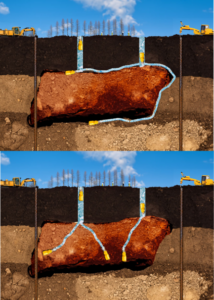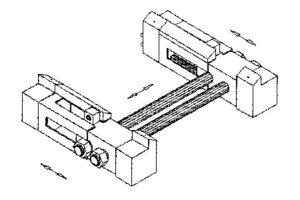Active Projects
Miniaturized Robotic Systems for Autonomous In-Situ Exploration of Critical Raw Materials In Deep Land Deposits
Acronym MINOTAUR
Exploration drilling for a sustainable future!
Exploration drilling is often hampered by inefficiencies and high environmental costs, making it challenging to locate the critical raw materials needed for modern industries. Traditional methods can be slow and ineffective, leading to increased resource depletion and ecological disruption. As demand for these materials grows, finding innovative solutions becomes crucial. With this in mind, the EU-funded MINOTAUR project will investigate exploration drilling from a revolutionary perspective. MINOTAUR integrates geological principles with advanced technologies such as robotics, digital twin technology, and artificial intelligence. By treating exploration as a resource-mapping challenge, it enhances decision-making and streamlines geological assessments, ultimately paving the way for more efficient and sustainable resource management.
MINOTAUR Objectives
MINOTAUR seeks to address the exploration drilling problem from a novel and revolutionary perspective, bringing together geological principles and concepts involved in exploration drilling with modern technologies such as robotics, digital twin technology, and artificial intelligence. Along the way, MINOTAUR proposes novel research directions in allied areas like geophysics, sensing technologies in geology, environmental impact modeling of whole mineral and production systems, numerical modeling of entire mineral systems related to critical raw materials, new drilling techniques, high-resolution sensing technologies, and artificial intelligence with novel data processing tools for a robust and expeditious geological assessment.
MINOTAUR takes a fundamentally fresh look at exploration drilling and approaches it as a source seeking and resourcing mapping problem, drawing inspirations from solutions in robotics, but where geology is a central part of the decision, with the outcomes of exploration enhanced through artificial intelligence and digital twin technology.
Website: https://www.minotaur-mining.eu/
Project’s Linkedin Page: https://www.linkedin.com/company/minotaur-mining/posts/?feedView=all
- Type of Action: HORIZON-RIA
- Call For Proposal: HORIZON-CL4-2024-RESILIENCE-01
- Duration: 1/11/2024-31/10/2027


Autonomous Exploration and Extraction of Deep Mineral Deposits
Acronym PERSEPHONE
The Aim
The continuous effort and increased demand of the raw materials are directing the mining companies to excavate minerals at greater depths. This trend is challenging the current mining operations and the existing traditional technologies towards the objective to retain profitability, while achieving the latest Green Deal environmental vision and securing human workers safety. A key enabler, to address these challenges and to foster a sustainable development of the mining industry, is the development and deployment of innovative technologies for resource efficient extraction of the EU’s raw materials, as well as near mine exploration of critical raw materials in currently non-extracted ore bodies in existing or abandoned ones.
PERSEPHONE is aiming to address these challenges by developing of the pioneering technologies for pushing the limits of EU mining industry and embodiment of autonomous and integrated near mine exploration capability to access deep deposits of critical raw materials through hard-to-reach deep and abandoned mines. The overall concept and vision of PERSEPHONE will be achieved by reducing the size of mining machines currently adapted to the human scale and embedding autonomy for risk-aware navigation and full digitalization of the extraction process by digital twin creation and key enabling technologies validation at TRL 5. Additionally, PERSEPHONE is introducing completely novel approaches in online near mine exploration core analysis and overall integration of related data analytics to the mine expansion. Thus, PERSEPHONE allows to foster green transition by reducing the cost and waste generated from deep-mining operations and foster the vision of zero human presence in highly hazardous areas. These will allow to achieve PERSEPHONE’s overall goal to digitalize and automate extraction value chain by creation of new concepts of energy-efficient autonomous drilling machines with advanced perception capabilities for navigation, face drilling, and core extraction, which will enable data-driven digital twin creation and geological modelling for further enhanced decision support and optimal extraction planning.
Website: https://www.persephone-mining.eu/
Project’s Linkedin Page: https://www.linkedin.com/company/persephone-mining/posts/?feedView=all
- Type of Action: HORIZON-RIA
- Call For Proposal: HORIZON-CL4-2023-RESILIENCE-01-02
- Duration: 1/1/2024-31/12/2026




